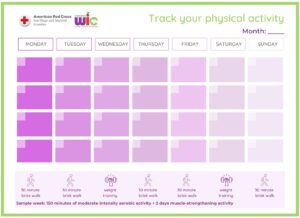Regular physical activity is good for your physical and mental well-being. Although we all know that, it can be hard to keep up a regular exercise routine. It’s normal to have questions, like:
- How much exercise should an average adult be getting?
- What changes if you’re pregnant, or postpartum?
- How do we fit moving our bodies into our often-busy schedules?
Recommended Amount of Activity
The Centers for Disease Control and Prevention (CDC) recommends different levels of activity for different age groups. For adults between 18 and 64 years of age, the recommendation is 150 minutes a week of moderate intensity activity, such as brisk walking, plus activities that strengthen muscles at least two days a week.
That much physical activity can seem like a lot, but you don’t have to do it all at once. It’s best to spread it out over the week, and you can even split it into smaller chunks during the day. Two 15-minute walks a day or even three 10-minute walks can seem more manageable than going for 30 minutes in one go.
Types of Activity
Any amount of physical activity will have some health benefits. You can move your body in any way that feels good to you. Have a dance party with your kids, go for a family walk after dinner or do some yoga poses before bed. As long as it’s moderate to vigorous intensity, it all counts!
Set Realistic Goals – and Stick to Them!
If your exercise routine isn’t what it used to be, don’t worry! We’ve all been there. Start by setting yourself realistic goals. Small, attainable goals make it more likely that you will accomplish them, and you deserve that! Hitting your goals will make you feel good – and keep you motivated. There are plenty of apps and digital tools that help track your activity. If you prefer something you can print, try this four week calendar:

You can write down what you did and for how long in the boxes below each day. There’s also an example at the bottom of how to divide your week.
Activity During and After Pregnancy
You might be worried about being physically active during or after your pregnancy. Research shows that the risks of moderate-intensity activity, like brisk walking, are low for healthy pregnant women. It does not increase your chances of low-birth weight, early delivery and early pregnancy loss.
Unless you have a medical reason to avoid physical activity, you can begin or continue moderate-intensity activities. It will help keep your heart and lungs healthy during and after pregnancy and can help you maintain or achieve a healthy weight.
You should be under the care of a doctor who can monitor the progress of your pregnancy. If you do have concerns about physical activity, talk to your doctor.
When to Talk to Your Doctor
Moderate physical activity is safe for most people. In some cases, the CDC recommends for you to talk to your doctor about what kinds and how much physical activity is safe for you to do.
- If you are pregnant or postpartum – talk to your doctor about whether or how to adjust your physical activity during and after your pregnancy.
- If you have a chronic condition, such as heart disease, arthritis, or diabetes – talk to your doctor about what kinds of physical activity is right for you.
- If you have been inactive, have a disability, or are overweight – talk to your doctor before starting exercise and engaging in vigorous intensity exercise.



